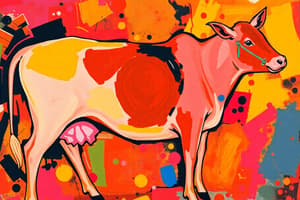Podcast
Questions and Answers
Animal reproduction is a fundamental aspect of life, driving the survival and evolution of ______.
Animal reproduction is a fundamental aspect of life, driving the survival and evolution of ______.
species
Understanding animal reproduction is crucial for shedding light on the complex processes that govern the ______ world.
Understanding animal reproduction is crucial for shedding light on the complex processes that govern the ______ world.
natural
Sexual reproduction involves the fusion of gametes (sperm and egg) from two sexually mature ______.
Sexual reproduction involves the fusion of gametes (sperm and egg) from two sexually mature ______.
individuals
Asexual reproduction occurs when a single individual produces offspring without the involvement of another ______.
Asexual reproduction occurs when a single individual produces offspring without the involvement of another ______.
The reproductive systems in animals are complex, consisting of various organs and structures designed to produce and transport ______.
The reproductive systems in animals are complex, consisting of various organs and structures designed to produce and transport ______.
Animals exhibit two main modes of fertilization: external, where gametes are released into the environment and fertilized outside the body, and internal, where fertilization occurs within the female's reproductive ______.
Animals exhibit two main modes of fertilization: external, where gametes are released into the environment and fertilized outside the body, and internal, where fertilization occurs within the female's reproductive ______.
Males possess testes that produce ______, while females possess ovaries that produce eggs.
Males possess testes that produce ______, while females possess ovaries that produce eggs.
Fertilization is the process by which gametes fuse to form a single ______, initiating the development of an embryo.
Fertilization is the process by which gametes fuse to form a single ______, initiating the development of an embryo.
After fertilization, the zygote develops into an ______, eventually giving rise to a new individual.
After fertilization, the zygote develops into an ______, eventually giving rise to a new individual.
Developmental patterns can vary significantly among animal groups, from direct development to indirect development, involving embryonic stages called ______ or fetuses.
Developmental patterns can vary significantly among animal groups, from direct development to indirect development, involving embryonic stages called ______ or fetuses.
Study Notes
Reproduction in Animals: A Biological Perspective
Reproduction is a fundamental aspect of life, driving the survival and evolution of species. In the realm of biological sciences, understanding animal reproduction is crucial for shedding light on the complex processes that govern the natural world. This article will explore the diversity of reproductive strategies in animals and highlight key aspects associated with their reproduction.
Diversity of Reproductive Strategies
Animal reproduction is characterized by a wide range of strategies, each suited to the species' unique ecological niche. Some of the most common strategies include:
-
Sexual reproduction: Involves the fusion of gametes (sperm and egg) from two sexually mature individuals. This is the most common strategy in animals, ensuring genetic variation and the potential for natural selection.
-
Asexual reproduction: Occurs when a single individual produces offspring without the involvement of another individual. This strategy is common in plants and some invertebrates, and while it can lead to rapid population growth, it may also limit genetic variation.
Reproductive Systems
The reproductive systems in animals are complex, consisting of various organs and structures designed to produce and transport gametes.
-
Sexual dimorphism: The reproductive systems of males and females are often distinct, leading to sexual dimorphism. For example, in mammals, males possess testes that produce sperm, while females possess ovaries that produce eggs.
-
External and internal fertilization: Animals exhibit two main modes of fertilization: external, where gametes are released into the environment and fertilized outside the body, and internal, where fertilization occurs within the female's reproductive tract.
Fertilization and Development
Fertilization is the process by which gametes fuse to form a single zygote, initiating the development of an embryo.
-
Fertilization: Fertilization can occur in various ways, including:
- Sperm competition: Multiple males may compete for fertilization, as seen in some insects and mammals.
- Internal fertilization: Sperm are introduced into the female's reproductive tract, as seen in mammals and birds.
- External fertilization: Gametes are released into the environment, as seen in fish and some amphibians.
-
Embryonic development: After fertilization, the zygote develops into an embryo, eventually giving rise to a new individual. Developmental patterns can vary significantly among animal groups, from direct development (e.g., some fish and amphibians) to indirect development (e.g., birds and mammals), involving embryonic stages called larvae or fetuses.
Conclusion
Understanding animal reproduction is essential for gaining insights into the complex processes that govern the natural world. By examining the diversity of reproductive strategies and the underlying reproductive systems and mechanisms, we can gain valuable knowledge that can inform conservation efforts, improve our understanding of evolutionary processes, and foster a deeper appreciation for the complexity of life on Earth.
For further reading, consult specialized literature, such as classical texts like Jan A. Pechenik's "A Short Guide to Writing about Biology" and Victoria E. McMillan's "Writing Papers in the Biological Sciences". Additionally, explore relevant research journals and databases such as Biological Abstracts and Science Citation Index.
Studying That Suits You
Use AI to generate personalized quizzes and flashcards to suit your learning preferences.
Description
Explore the diverse strategies and mechanisms of animal reproduction from a biological perspective. Learn about sexual and asexual reproduction, reproductive systems, fertilization processes, and embryonic development in various animal groups.




